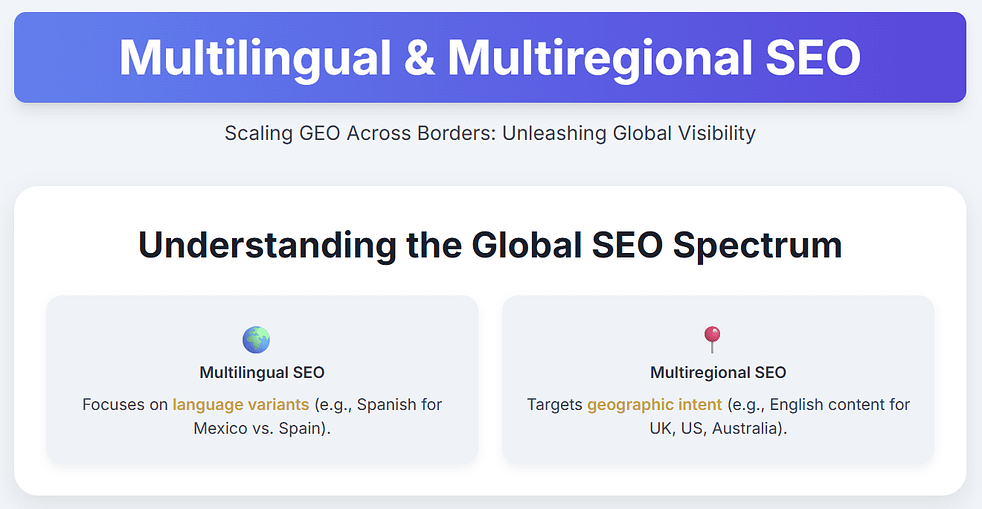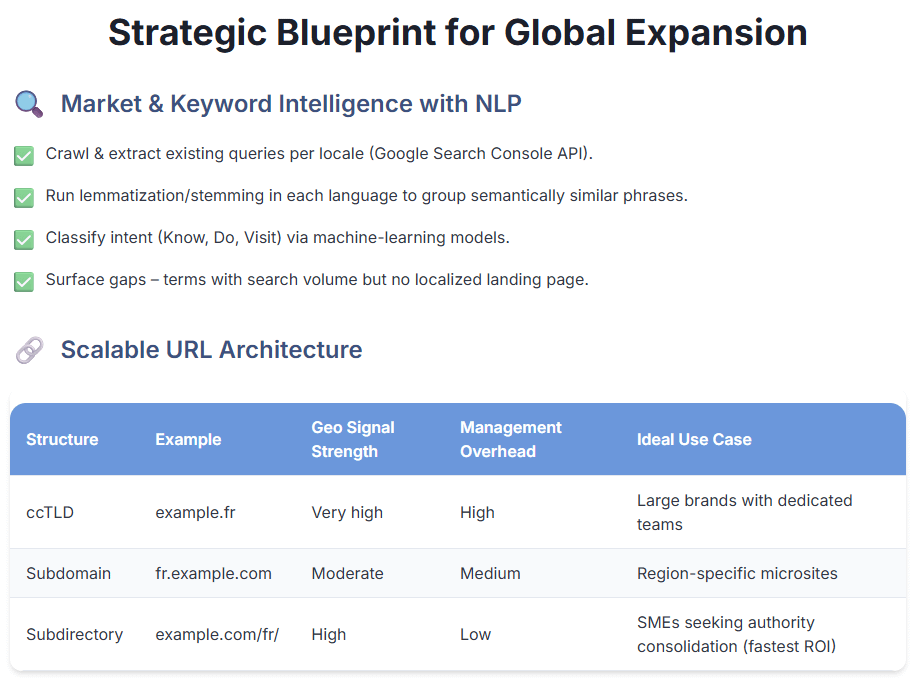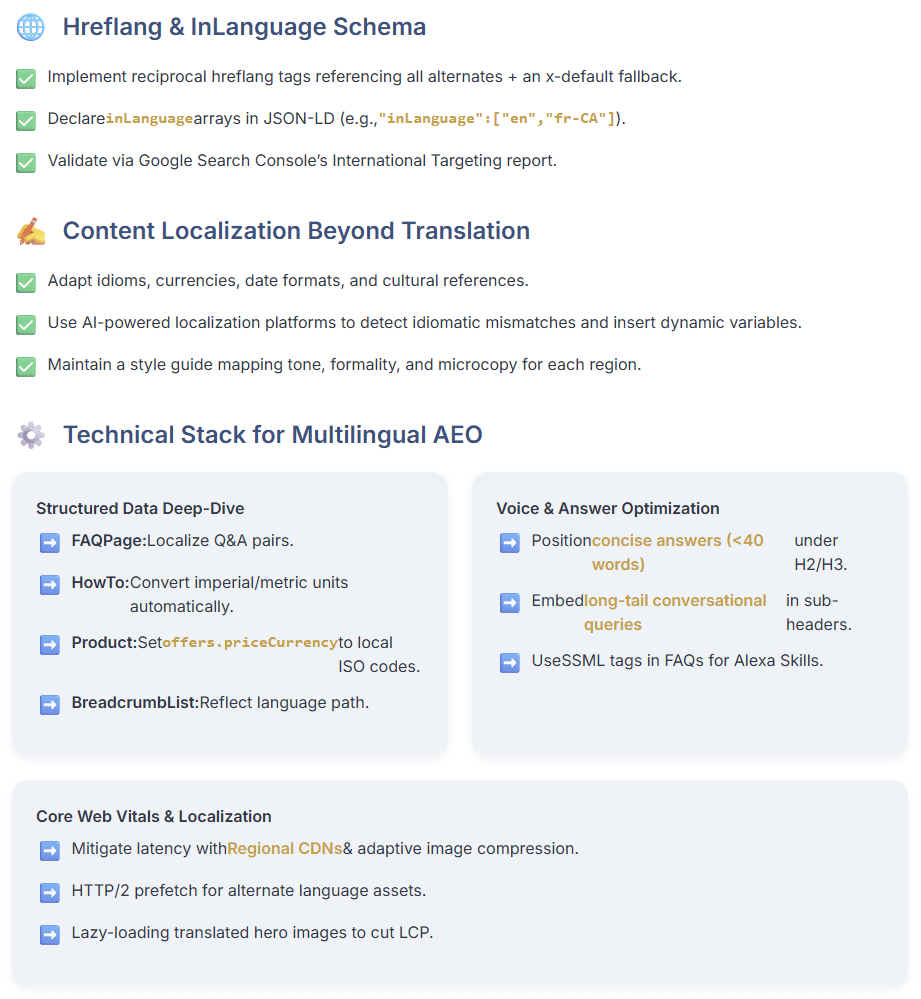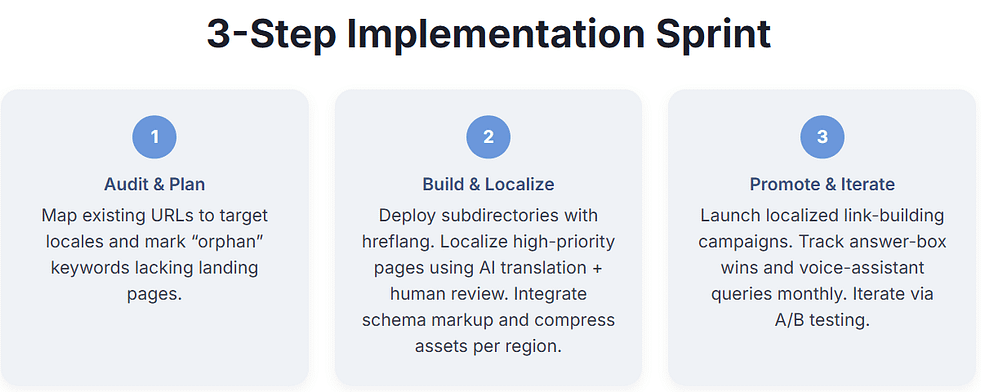Unleashing global visibility demands more than translating copy. Multilingual and multiregional SEO fuse linguistic nuance, geographic targeting, and answer-engine optimization (AEO) to ensure every searcher—human or AI—receives the right content in the right language at the precise micro-location. This deep-dive guide arms you with proven tactics, NLP workflows, and GEO-scale frameworks to dominate SERPs and AI-driven answer boxes across continents.
Understanding the Global SEO Spectrum
Multilingual vs. Multiregional Fundamentals
Search engines treat language and region as two distinct but overlapping signals[1][2].
- Multilingual SEO focuses on language variants—e.g., Spanish for Mexico and Spain.
- Multiregional SEO targets geographic intent—e.g., English content for the UK, US, and Australia—even if the language remains constant[3][4].
Why GEO Scaling Matters in 2025
- Voice assistants process 8.4 billion queries monthly worldwide, most in conversational language[5][6].
- AI answer engines (Google SGE, Bing Copilot) prioritize direct answers and entity-rich markup[7][8].
- 67% of sites still misconfigure hreflang, causing cannibalization and duplicate-content penalties[9].

Strategic Blueprint for Global Expansion
Market & Keyword Intelligence with NLP
Natural-Language Processing automates multilingual keyword clustering and intent mapping.
- Crawl & extract existing queries per locale using Google Search Console API.
- Run lemmatization/stemming in each language to group semantically similar phrases.
- Classify intent (Know, Do, Visit) via machine-learning models, then align to funnel stages[10][11].
- Surface gaps—terms with search volume but no localized landing page[12][13].
Choosing a Scalable URL Architecture
Structure | Example | Geo Signal Strength | Management Overhead | Ideal Use Case |
ccTLD | Very high[14] | High[15] | Large brands with dedicated teams | |
Subdomain | Moderate[15] | Medium | Region-specific microsites | |
Subdirectory | Low | SMEs seeking authority consolidation |
Google affirms any pattern can rank if implemented consistently, but subdirectories often offer the fastest ROI for mid-tier budgets[17][16]. Same is reciprocated by likes of SARK Promotions and Neil Patel.
Hreflang & InLanguage Schema
- Implement reciprocal hreflang tags referencing all alternates, plus an x-default fallback[18][19].
- Declare inLanguage arrays in your JSON-LD to list multiple language codes (e.g., “inLanguage”:[“en”,”fr-CA”])[20][21].
- Validate via Google Search Console’s International Targeting report to avoid 404/302 loops[2].


Content Localization Beyond Translation
Localization means adapting idioms, currencies, date formats, and cultural references[22][23]. Use AI-powered localization platforms to:
- Detect idiomatic mismatches via sentiment analysis.
- Insert dynamic variables for city names, shipping costs, and holidays per locale.
- Maintain a style guide mapping tone, formality, and microcopy for each region[24][11].
Technical Stack for Multilingual AEO
Structured Data Deep-Dive
Schema Type | Purpose | Implementation Tip |
FAQPage | Captures common questions | |
HowTo | Step-by-step tutorials | Convert imperial/metric units automatically per region[26][21] |
Product | E-commerce listings | Set offers.priceCurrency to local ISO codes (e.g., INR, EUR)[27] |
BreadcrumbList | Hierarchical cues | Reflect language path: /es/categoria/producto/[19] |
Voice & Answer Optimization
- Position concise answers (<40 words) under H2/H3 headings to feed featured snippets[7][28].
- Embed long-tail conversational queries (“¿Cuál es el mejor seguro de viaje para España?”) in sub-headers to align with voice search patterns[29][30].
- Use <speak> SSML tags in FAQs for Alexa Skills where relevant[5].
Core Web Vitals & Localization
Latency spikes increase with distance from your origin server. Mitigate with:
- Regional CDNs and adaptive image compression.
- HTTP/2 prefetch for alternate language assets.
- Lazy-loading translated hero images to cut LCP by up to 35% in high-resolution markets[12].
GEO-Targeted Link Building & Signals
Local Authority Drivers
- Country-specific TLD backlinks (.de, .co.jp) carry stronger regional relevance than generic .com sources[14][27].
- Secure citations in native directories (e.g., SeitenAnzeiger.de) to reinforce NAP consistency.
- Run regional PR campaigns pegged to local events and holidays, then syndicate across language-matched media outlets[23][31].
User Engagement Metrics
Google’s RankBrain monitors dwell time and pogo-sticking per locale. Enhance UX via:
- Auto-detect language, offer unobtrusive switcher banner.
- Display localized social proof (trust badges, reviews) to boost engagement signals[32][33].
Monitoring & KPI Framework
KPI | Tool | Multilingual Insight |
Clicks & Impressions | Google Search Console | Segment by Language/Country dimension[3] |
SERP Features | SEMrush Sensor | Track featured snippets & People Also Ask appearances per market[34] |
Voice Share | Bing Webmaster > Performance | Measure Cortana/Edge voice traffic in target locales[5] |
Answer Box Presence | RankMath AEO report | Percentage of pages occupying AI answer panels[25] |
Set quarterly targets for each KPI, then refine content via NLP-based topic modeling to shore up under-performing intents.

3-Step Implementation Sprint
- Audit & Plan
- Map existing URLs to target locales and mark “orphan” keywords lacking landing pages[13].
- Build & Localize
- Deploy subdirectories with hreflang.
- Localize high-priority pages using AI translation + human in-market review.
- Integrate schema markup and compress assets per region.
- Promote & Iterate
- Launch localized link-building campaigns.
- Track answer-box wins and voice-assistant queries monthly.
- Iterate via A/B testing of meta titles, schema rich results, and interlinking depth.

Frequently Asked Questions
Q1. What’s the quickest way to add hreflang to 1,000+ pages?
Generate a dynamic XML sitemap with hreflang attributes (preferred for large sites) instead of hard-coding in HTML[18][35].
Q2. Do I need separate Google Business Profiles for each country?
Yes. Create one GBP per physical location to feed local pack results, even if your main domain remains global[23][36].
Q3. How can I measure voice search traffic?
Filter “query string = Unknown (Voice)” segments in Google Search Console and compare against rising impressions of question-style queries[29][6].
Q4. Will AI translation hurt my SEO?
Only if left unreviewed. Pair MT engines with professional linguists for post-editing, then run automated quality checks for grammar, brand tone, and schema consistency[10][11].
Conclusion
Scaling GEO across borders hinges on orchestrating language, location, and intent. By leveraging NLP for keyword intelligence, implementing rigorous hreflang and schema protocols, and optimizing for answer engines, you’ll outmaneuver competitors and satisfy users from Ghaziabad to Guadalajara. Bid farewell to one-size-fits-all SEO—your multilingual, multiregional strategy is now primed for global domination.
Citations
- https://www.aumcore.com/blog/seo-guide-for-multi-regional-and-multilingual-sites/
- https://searchengineland.com/international-seo-everything-you-need-to-know-450866
- https://www.kala.agency/everything-you-need-to-know-about-multiregional-seo/
- https://error404.atomseo.com/blog/multiregional-seo
- https://www.linkedin.com/pulse/voice-search-optimization-multilingual-approaches-seo-mounir-l-
- https://www.eurodev.com/blog/navigating-the-voice-search-revolution-with-multilingual-seo
- https://www.ezrankings.com/blog/answer-engine-optimization/
- https://www.marceldigital.com/services/search-engine-optimization/aeo
- https://backlinko.com/hreflang-tag
- https://www.sapien.io/blog/how-to-localize-nlp-models
- https://contentech.com/how-do-ai-and-nlp-improve-localization/
- https://syspree.com/blog/international-seo/
- https://www.prontomarketing.com/blog/how-to-develop-your-international-seo-strategy/
- https://ralfvanveen.com/en/seo/the-importance-of-cctlds-versus-subdirectories-for-global-seo/
- https://seobotai.com/blog/subdomain-vs-subdirectory-vs-cctld-for-seo/
- https://www.searchenginejournal.com/subdomain-subdirectory-cctld-which-one-should-you-use/448277/
- https://www.reddit.com/r/TechSEO/comments/qcmgww/international_seo_is_there_much_of_a_difference/
- https://moz.com/learn/seo/hreflang-tag
- https://rankmath.com/blog/hreflang-tags/
- https://stackoverflow.com/questions/73577373/how-would-you-specify-multiple-languages-for-a-schema-with-inlanguage-property
- https://www.schemaapp.com/schema-markup/how-to-implement-schema-markup-for-multilingual-or-multi-regional-sites/
- https://www.weglot.com/guides/multilingual-seo-tips
- https://www.outerboxdesign.com/uncategorized/geo-targeting-marketing-roi
- https://www.typeface.ai/blog/ai-powered-content-localization-to-scale-content-marketing
- https://surferseo.com/blog/answer-engine-optimization/
- https://wpml.org/documentation/how-to-set-up-multilingual-seo-on-your-website/
- https://www.shopify.com/in/blog/international-seo-strategy
- https://cxl.com/blog/answer-engine-optimization-aeo-the-comprehensive-guide-for-2025/
- https://www.linguise.com/blog/guide/optimize-your-website-for-multilingual-voice-search/
- https://veracontent.com/mix/multilingual-voice-search/
- https://elatre.com/geo-targeting-best-practices-for-small-businesses-in-2024/
- https://strapi.io/blog/multilingual-seo-best-practices
- https://www.digitalsuccess.us/blog/how-to-manage-multilingual-and-multiregional-seo-most-important-factors-tools-tactics.html
- https://www.bluehost.in/blog/expert-seo-tips-for-multilingual-websites/
- https://multilingualpress.org/hreflang-tags/
- https://www.klientboost.com/ppc/geotargeting/




